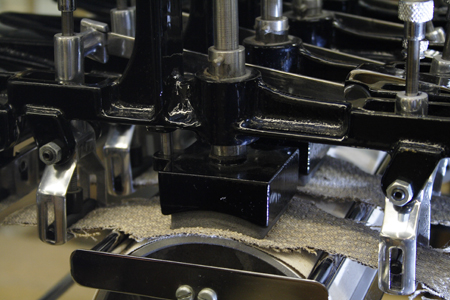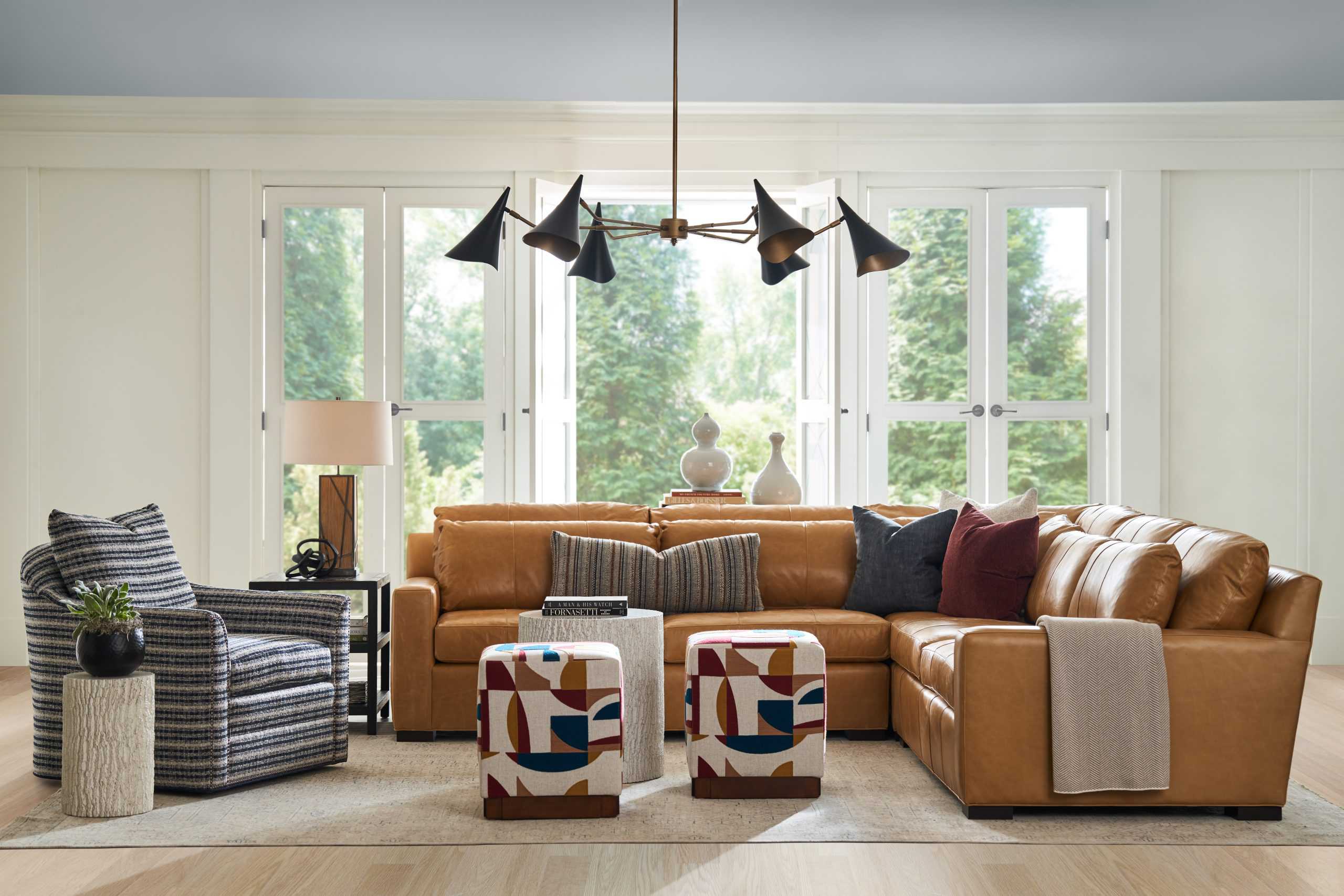Performance fabrics – it’s a term you’ve probably seen or heard more and more in the past several years as the furniture industry has responded to our ever growing desire to really LIVE in our homes. We’ve seen this shift over the past 10 or so, at first with a handful of stain resistant fabrics being introduced, complete with demos of coffee and red wine gliding off of white velvet (it was an exciting time!) Since then, there has been a steady increase in both supply and demand of these pet/kid/life friendly fabrics for the home.The global pandemic accelerated this demand as everyone was suddenly using their furniture at a rate no one had ever seen before (our sofas have never really recovered from the sheer volume of Netflix marathons they had to endure, have they?)
So, what exactly is a Performance fabric? Is it durable? Stain resistant? Pet-friendly? Or all of the above. We’re here to set some of those facts straight and empower you with the knowledge you need when making your next upholstery purchase.
Myth 1: Performance is an industry standard term
Ah Performance – an ever pervasive term in the fabric industry… but what does it really mean??? Some have the impression that “Performance” is a specific, all encompassing industry standard term. The reality is that performance is really an adjective used to describe any of the following traits: Durability (double rub/abrasion), stain resistance, water-resistance, anti-microbial, mould and mildew resistance, light fastness (UV resistance).

A performance fabric can have one or all of these traits to be considered as such, so it’s extremely important to look at the specific qualities of the fabric and your needs before selecting. If you’re decorating a sunroom or screened in porch, UV and mould/mildew resistance should be top priority, while the family room might be better served by durability and stain resistance. If you have pets (especially cats), a tightly woven fabric like velvet, denim, or microfibre (whether or not it’s technically “performance”) will fare better than a looser weave. It’s all about your individual lifestyle!
:max_bytes(150000):strip_icc():format(webp)/great-pet-friendly-fabrics-1976777-01-c10c4e040dc244bdb051305ab8df7695.jpg)
Myth 2: Higher rub count = better
This is a common belief that we run into on a VERY regular basis. We often have clients and customers come into the showroom with the firmly held belief that they need the highest rub count possible to accommodate their active household with children and pets. The truth is that while, yes, we do need to consider rub count in our fabric selection process, there is a threshold of perfectly acceptable durability that one does not really need to cross in order for a fabric to last. Up until about 10 years ago, residential fabric rub counts rarely went past the 30,000-50,000 range, and these numbers were considered heavy duty, with anything above being considered contract/hospitality grade. These fabrics held up perfectly fine for decades prior to the new generation of 100,000+ double rub fabrics, and the same holds true today! For most homes (even very active ones), fabric within that 30,000-50,000 is perfectly acceptable and will likely last the lifetime of the piece of furniture or beyond.
Further to that point, there are two different methods of testing: Wyzenbeek (double rub count) or Martindale (abrasion count) tests. The numbers they produce do not correlate to one another, making it difficult when comparing fabrics. Additionally, there is no formal governing body overseeing these tests, so the fabric manufacturer conducts this test themselves and we as the consumer rely on the honour system.

Lastly, the increasing effectiveness (for lack of a better word) can be likened to SPF, in that the difference is greater in the lower range than the higher range. So, for example, we are aware that the difference between SPF 30 and 40 is greater than that of SPF 80 and 90.
Sadly, we see many folks pass over beautiful fabrics that work better with their design scheme and that they actually like more for fabrics with a higher rub count as they are convinced this is what they need.
The reality is that some of these fabrics are designed for hotels and restaurants, and are simply overkill for daily home use (not that there is anything inherently wrong with choosing such a fabric, but it shouldn’t be the main deciding factor.)
Myth 3: Pilling is a defect/means the fabric isn’t durable/performance
Pilling might be one of the most misunderstood issues within the furniture industry, with many believing that it is a defect of the fabric or a sign of poor quality and/or durability. We’re here to tell you that this simply is not the case.

But, what really is pilling (other than unsightly and yes, annoying)? Pilling is the balling of loose of fibres as result of friction on the surface of a fabric – something we are all familiar with whether in our clothing or upholstered furniture. Certain types of fabrics are more likely to pill than others – think a coarse, open weave vs a tightly woven, smooth fabric such as velvet.
Other factors to consider are the type of fibres that are present in the fabric – natural vs. synthetic, and long vs. short. The longer the fibres are, the less likely they are to pill. In regards to natural vs. synthetic, this is where it gets a little tricky… natural fibres like wool and cashmere (especially if they are short) are likely to release more easily than synthetic, so pills may form but are easy to remove. Synthetic fibres on the other hand tend to be much stronger, so if and when they release, pills are more likely to form, are usually more obvious and can be somewhat challenging to remove.
Because most performance fabrics are synthetic, they absolutely can pill! Again, this depends on the type of weave, specific fibre content and length of the fibres.
We recommend keeping a simple manual sweater shaver at home to tackle any pills as they come.
Myth 4: Performance fabrics are bulletproof.
When Performance fabrics really began to arrive on the residential design scene, we were all dazzled by those videos of red wine effortlessly gliding off a snow white sofa. It was a revolution, and one we were excited to share with our clientele. However, the truth of the matter is that these fabrics are still, well… fabrics, and depending on the type of fibres, the weave, and the colour, the results vary when it comes to just how they perform. Don’t get us wrong, certain stain resistant fabrics are amazing, but they have their limits.

For example, a navy blue velvet and a white linen with the exact same stain resistant treatment will likely behave differently when met with a spill of red wine. Likewise, performance fabrics can pill, even ones with a high double rub count as this is not necessarily considered a reflection of its durability.
There is also a common misconception that performance fabrics do not need to be maintained and this is simply not true! It is always advised to care for your fabrics as advised by the manufacturer to ensure longevity and keep your furniture looking fresh and beautiful.
The Long And the Short Of It
As you might have guessed at this point, the world of fabric is highly nuanced! For this reason, painting all Performance fabrics with the same brush just doesn’t make sense.
Our view on Performance fabrics (specifically stain resistant varieties), is that they are a fabulous extra layer of defence against life’s little mishaps, but they will not miraculously clean themselves, nor allow you to neglect your furniture. We have made a concerted effort to continually educate ourselves on the topic by asking lots of questions as well as remaining curious and open-minded in order to best serve our clients.
Anything that allows you to live a little more in a space is a thumbs up in our books, and being empowered with proper knowledge and realistic expectations before buying your furniture is a recipe for success.


